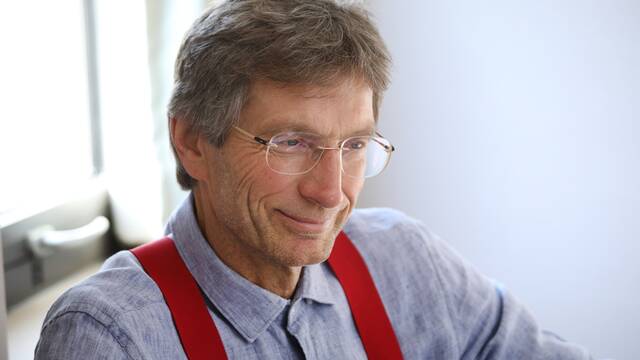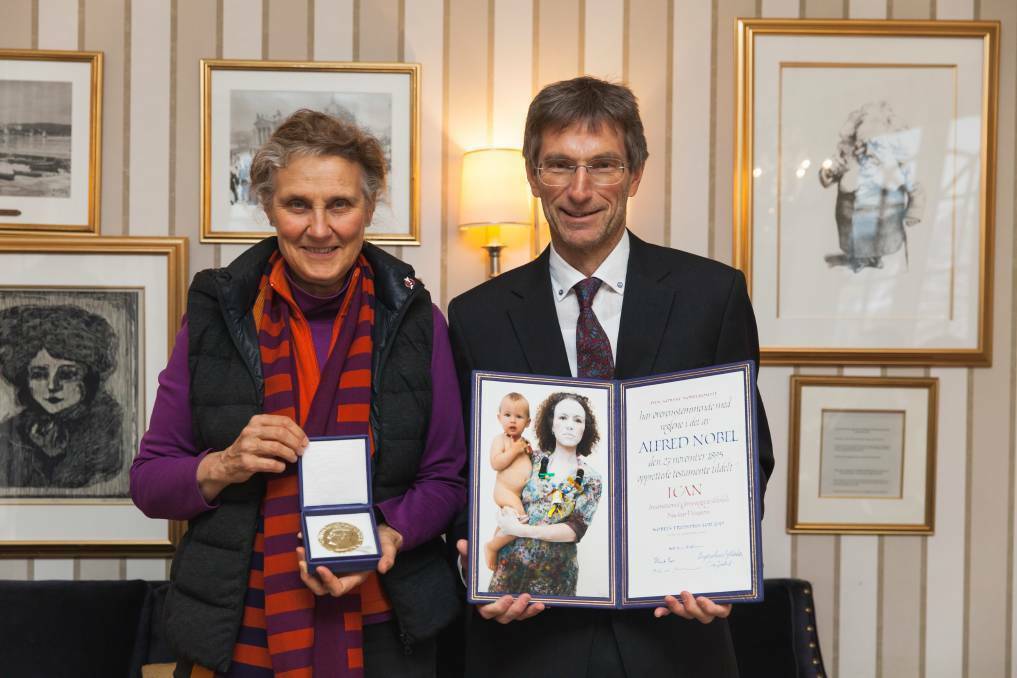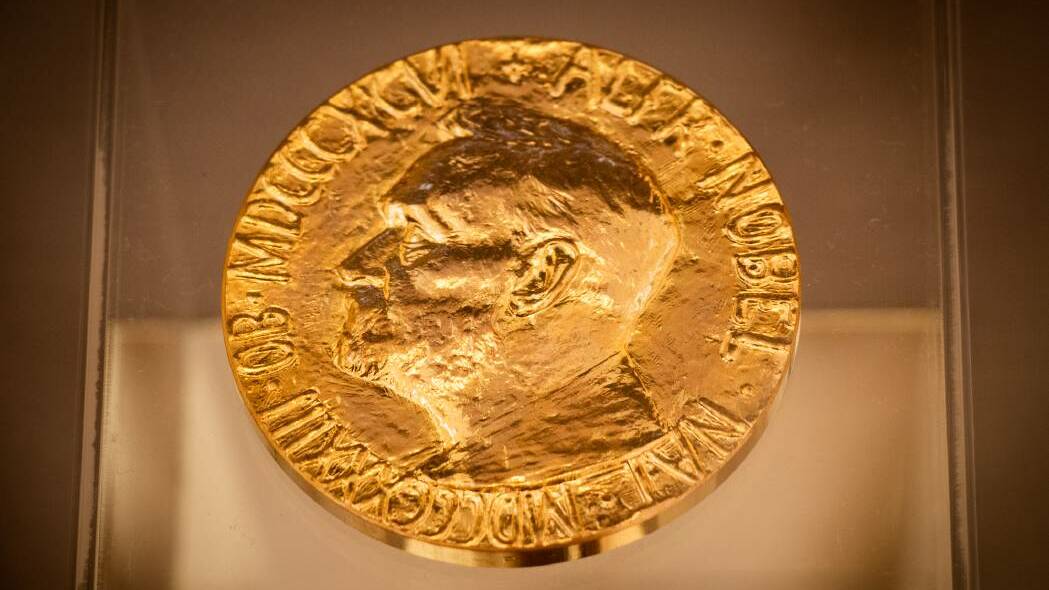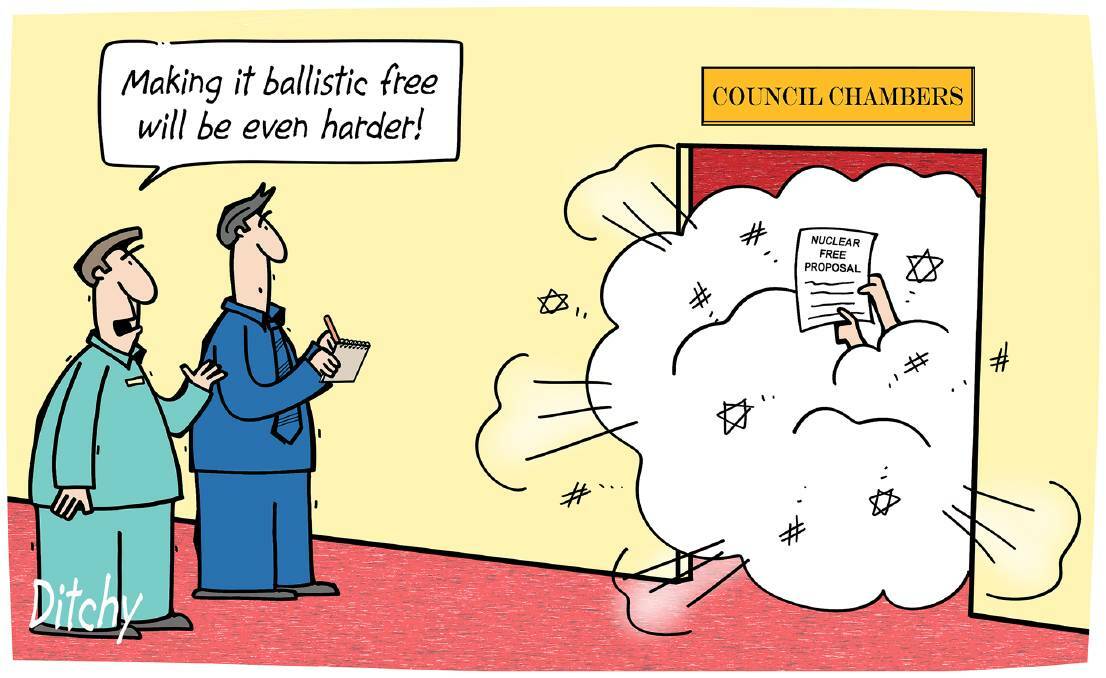
"Peace... is for people to live in conditions that are free of the threat of indiscriminate violence erupting on them at any point, but also a world that secures the basic needs of everybody and does it with justice to future generations, without compromising their ability to live a full and peaceful life."
Subscribe now for unlimited access.
$0/
(min cost $0)
or signup to continue reading
And the best way of working towards a peaceful and just world is to rid it of atomic weapons. Doing so has been the life's work of Associate Professor Tilman Ruff AO, a physician based in Melbourne.
Background
Training in infectious diseases, Dr Ruff has undertaken a lot of work on vaccine introduction and development - particularly for the hepatitis B vaccine - throughout his career.
But for the past 40 years his work has been focused on a different issue: nuclear weapons.
When the World Health Organisation identified nuclear weapons as the "greatest immediate threat to human health and welfare" in 1984, given that no health service would be capable of dealing with the hundreds of thousands of people injured by the blast, heat or radiation following a bomb, the "very solid evidence underpinning it" struck Dr Ruff.
He began to question why such an acute existential threat to humanity was receiving so little attention from health professionals and since then, he has focused his attention on using health and scientific evidence to underpin advocacy and draw attention to policy implications.
Most of this work has been through two organisations - an international medical group called the International Physicians for the Prevention of Nuclear War (which was awarded a Nobel Peace Prize for its work in 1985) at which he is now a co-president.
He was also part of a group of passionate individuals sitting at a table in Carlton discussing the issue of nuclear weapons in 2005 and from there, the International Campaign to Abolish Nuclear Weapons (ICAN) was launched in Melbourne.
It has grown to become a major civil society coalition and has worked with partner organisations and governments to negotiate an historic treaty.

For this significant work towards the creation of a treaty to prohibit "the worst of all weapons" for the first time, ICAN became the first Australian-born entity - organisation or person - to have its work recognised with a Nobel Peace Prize in 2017.
The United Nations Treaty for the Prohibition of Nuclear Weapons came into effect on January 22, 2021, and on this day Dr Ruff spoke at the first Let's Talk Peace Ballarat event, hosted as a virtual forum.
It was also a significant day for Dr Ruff as it marked 31 years to the day since he had major surgery for cancer. He said he was "so pleased" to have lived through it to achieve what he has.

The day was also significant, Dr Ruff said, as it aligned with a new government in the United States, which has already vowed to take action in relation to nuclear weapons.
Another significant day was marked on January 24, 1946 - the 75th anniversary of the first resolution of the United Nations General Assembly. Founded in the aftermath of "the most destructive and terrible war there had ever been", the preamble of the UN charter states that it is to save succeeding generations from the scourge of war.
At its first meeting, the General Assembly called for the elimination of atomic weapons.
Why eliminate nuclear weapons?
Dr Ruff said that even a limited nuclear war, such as between India and Pakistan, would be an "absolute global catastrophe that would end modern industrial civilisation."
A bigger nuclear war, such as one using Russian and American arsenal, would "very likely be the end of humankind and many other species".
The biggest nuclear weapon ever exploded, the Tsar Bomber, was detonated in the Arctic Ocean in 1961.
It contained about 50 million tonnes of high explosives - about four times more than all of the explosives that have ever been used in all the wars throughout human history.
One of the problems with nuclear weapons is just the unbelievable scale of their potential of destruction
"One of the problems with nuclear weapons is just the unbelievable scale of their potential of destruction," Dr Ruff explained.
"But the other thing is that apart from the blast and the fires, there's also the radiation effect, which is unique to nuclear weapons, and which absolutely respects no borders, needs no passport and travels with the wind and the rain and ocean currents around the world."
The other impact, which is now better understood, is the impact on the climate.
"Nuclear weapons are extremely efficient at igniting essentially everything that will burn over a very large area," he said.
This was seen with even the relatively small weapons used in Hiroshima and Nagasaki, Dr Ruff said, where basically everything in the city burnt.
Dr Ruff said exploding a nuclear weapon - which is on average about 13 times bigger than what was used at Hiroshima - would burn a whole city to the ground and push "millions of tonnes of dark black smoke into the atmosphere, which heated and stabilized, would spread around the world and go right up into the stratosphere, sort of out of the reach of the clouds, and the weather persists for over a decade".
This would cool and dry the climate underneath - decimating agriculture and result in starvation across the globe.

"The biggest source of casualties from nuclear weapons would be from fires but in the longer term by far the biggest source of casualties would be from the famine caused by abrupt, Ice Age conditions that would develop over a matter of days.
"We're not equipped to cope with it, and Australia wouldn't be spared. Nowhere would be spared, essentially. So this is very much an issue for Australia."
In terms of global priorities, Dr Ruff said getting rid of nuclear weapons was the only reliable way or ensuring a nuclear war was to never occur.
"It has to be at the top of all of our concerns because it affects us all. It's not just an issue for any particular group or for governments - everybody would be affected if nuclear weapons were used. So everybody's got something at stake and everybody's got an interest in making sure that the end of nuclear weapons are not the end of us."
History of nuclear weapons in Australia
Unbeknownst to many, Australia also has a history of nuclear weapons. In the 1950s, Britain started to develop its own and tested them in Australia and then on Christmas Island.
There were 12 full-scale nuclear explosions in Australia between 1952 and 1956, with most at Maralinga in South Australia.
The fallout from this dispersed across the whole continent - with every major city dusted due to the wind at the time - with the exception of a small southwest corner in Western Australia.
In addition, there were also more than 600 'minor trials'.
These tests continued until the early 1960s and dispersed highly enriched uranium, plutonium, beryllium and other toxic chemicals in nuclear weapons near Maralinga.

Much of the land is still contaminated and unfit for human habitation, meaning it is a huge loss for Indigenous people.
"The legacy is long term - the main plutonium isotope has a half life of 24,400 years, "Dr Ruff said, meaning it was a legacy imposed on future generations of Australians, who would need to monitor the environment there.
While many of those who worked on the test program went on to develop cancer, Aboriginal people living in the area were also exposed.
"So this is a legacy that Australians shouldn't follow from that bitter experience about the indiscriminate and long term effects of nuclear weapons. But it's a part of our history that I think is not really widely enough known."
What can we do in Ballarat?
While the newly instated treaty is a positive step forward, it is not the end of nuclear weapons.
Dr Ruff said getting rid of nuclear weapons and addressing climate change were fundamental preconditions to making progress towards peace on every other important issue that matters - such as pandemics, poverty and race.
"To progress towards a more peaceful, secure and sustainable future for everybody depends on not ending the world abruptly in a nuclear Ice Age and nuclear famine, which essentially could make everything else that's been built over the millennia and everything that people strive and work for and that we hold dear absolutely irrelevant."
Many humanitarian and health organisations, as well as faith leaders, are now urging governments to join the treaty.
Dr Ruff said all Australians could play a part too.
"The main job for Australians is to get our government on the right side of history and to join this treaty rather than oppose it. So that means building support through parliamentarians, local governments and community organisations," he said.
Currently, 88 federal members of parliament have committed to supporting and working towards Australia joining the treaty, while more than 250 state and territory members have also committed.

"But we need to build more cross party support for this as a humanitarian, rather than a political, initiative," he said, adding this could be achieved by everybody approaching their local members of Parliament and encouraging them to join the Parliamentary Friends of the Treaty Group.
Dr Ruff said that if nuclear war occurred, local government would be affected just as much as the other levels as they are closest to the community and provide the basic services communities require.
"There's an important role for communities to mobilise to have their councils express their support for the treaty as it is cities that are the targets of nuclear weapons."
So far 32 local governments have joined the city's pledge to support the treaty, with many undertaking innovative approaches to communicate their decision back to their communities and ensuring that investments are not in companies making nuclear weapons.
Dr Ruff said people can also take personal actions such as ensuring their banks or super funds are not investing in companies building nuclear weapons.
If they are, Dr Ruff said it was worth contacting them to express displeasure or to swap to a more ethical institution.

